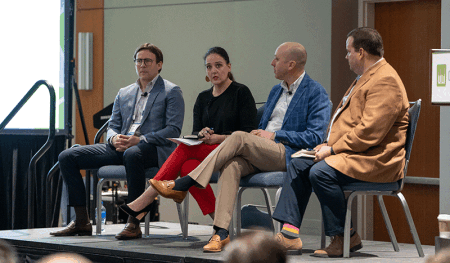“It has been a historic run,” said Matthew Gardner, CBRE’s head of life sciences for the Americas, speaking at ULI’s 2023 Carolinas Meeting in February.
Gardner was addressing the U.S. market for life-sciences real estate. While the field had been hot since around 2015, it began to boom in 2020 as a result of the COVID-19 pandemic and the race to create a vaccine. That boom hit a peak in mid-2022, and the market has since cooled. But the contraction has been relatively mild, said Gardner.
“The absorption rate has slowed, but not at the levels we feared,” he explained. In many of the nation’s hottest life-sciences markets, like Boston and San Francisco, vacancy rates still hover around 2 percent. While conversions of existing spaces have slowed, the pace of new construction remains steady.
And the potential for continued growth is robust. Among venture capital firms, the funding is there to support startups. Meanwhile, the rate of drug development has increased. In 2000, there were 2,000 phase two and phase three clinical trials happening throughout the country; a decade later, only 3,000 were occurring. This year, 12,000 trials are taking place.

From left to right: Chase Kerley, managing director at Crescent Communities; Sarah Gaskill, head of sustainability and environmental, social, and governance (ESG) at Fujifilm Diosynth Biotechnologies; Michael Haley, executive director of Wake County’s economic development department; and Matthew Gardner, CBRE’s head of life sciences for the Americas, speaking at the 2023 ULI Carolinas Meeting in Raleigh.
“The fundamentals are still overwhelmingly positive,” said Gardner.
Gardner was speaking in North Carolina’s Raleigh-Durham metropolitan area, one of the nation’s top five regions for life science companies. That market, said Gardner, “has seen a generational wave of new construction,” absorbing $10-$15 billion in new investment over the past three years. It hasn’t just occurred in the Research Triangle Park or downtown Raleigh: new life science companies are locating all over Wake County and the wider region.
But one municipality stands out. The town of Holly Springs—also in Wake County and located 25 miles (40.2 km) southwest of Raleigh—has been remarkably successful at attracting new life science investment, in the form of both research and development, as well as biomanufacturing. According to CBRE, over 40 percent of life sciences investment regionally over the last four years has gone to the town, which has more than quadrupled in population since 2000.
That’s no fluke. Panelists at the event agreed that the municipality’s success has been the result of its fortuitous location, as well as partnerships and long-range planning efforts that started at least 20 years before any companies arrived.
Labor is one of a company’s most important resources, and therefore arguably the biggest consideration when firms decide where to go. Holly Springs’ location—close to Duke University, University of North Carolina at Chapel Hill, and North Carolina State University—has been pivotal.
“It starts with the higher education ecosystem,” said Michael Haley, executive director of Wake County’s economic development department. He pointed out that the region sees roughly 42,000 college graduates every year, as well as PhDs and other higher-degree graduates, who are able to fill a variety of positions. “There’s talent across a spectrum.”
Sarah Gaskill, head of sustainability and ESG at Fujifilm Diosynth Biotechnologies, agreed. Fujifilm is building a $2 billion plant in Holly Spring that could employ over 700 people. “A current and future workforce pipeline is always what a company will look for.” She explained that Fujifilm has a partnership with Wake Technical Community College, to ensure that the institution is preparing students to fill potential jobs at the company.
High-quality infrastructure that’s already in place is also critical, said Chase Kerley, managing director at Crescent Communities, a commercial real estate development company based in Charlotte. His company is building The Yield, a speculative site for lab, office, and biomanufacturing companies that sits on 230 acres (93.1 ha) across three Holly Springs campuses.
“You can’t just put a sticker on [a site] and call it ‘life sciences,’” Kerley explained. Both laboratory space and biomanufacturing have very high standards for air, water, wastewater, and power, and many companies also insist on clean energy resources. “We wanted to be able to build on that infrastructure and ecosystem, not have to invest in it or create it,” said Kerley. His company’s question was, “Is local government able to help facilitate that?”
In Holly Springs, it was. The state, county, and municipal governments partnered with utilities and other vital stakeholders to anticipate what future life science companies—and developers—might need.
And that’s crucial. After all, if a company has a hit product on its hands, it needs to be able to ramp up rapidly in order to meet demand. But speed to market doesn’t just happen: it’s the result of intensive planning on the front end.
“It’s remarkable how many things have to line up for this to work,” said Gardner.





